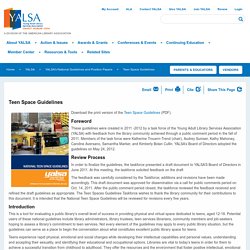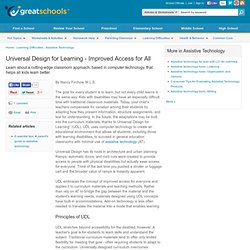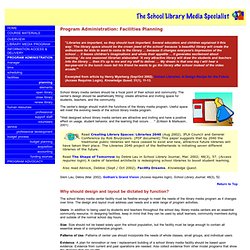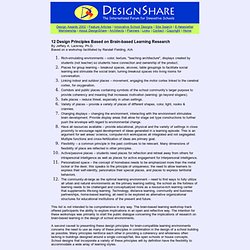

Photo editing websites. Creating library space that adds to the community and respects it - Strategic Plan 2012-2015. Every day, thousands of people use Toronto Public Library branches to read, study, collaborate, borrow books, use the computer, attend a program or meeting and more.

There is great demand for public space. The variety of use and space needs in library branches is ever increasing. Designing Libraries - Planning school libraries. Teen Space Guidelines. Download the print version of the Teen Space Guidelines (PDF).

Foreword These guidelines were created in 2011 -2012 by a task force of the Young Adult Library Services Association (YALSA) with feedback from the library community achieved through a public comment period in the fall of 2011. Members of the task force were Katherine Trouern-Trend (chair), Audrey Sumser, Kathy Mahoney, Caroline Aversano, Samantha Marker, and Kimberly Bolan Cullin. YALSA’s Board of Directors adopted the guidelines on May 24, 2012. Review Process In order to finalize the guidelines, the taskforce presented a draft document to YALSA’S Board of Directors in June 2011. The feedback was carefully considered by the Taskforce; additions and revisions have been made accordingly. Introduction This is a tool for evaluating a public library’s overall level of success in providing physical and virtual space dedicated to teens, aged 12-18.
Guidelines for Physical Space 2.1 Convey that it is teen-owned and maintained. 3.0. Facilities Design and Maintenance Dropbox. Learning UD. What is Universal Design?

Universal Design is an approach to the design of all products and environments to be as usable as possible by as many people as possible regardless of age, ability or situation. Other terms for Universal Design used around the world include Design For All, Inclusive Design, and Barrier-Free Design. Terminology and meanings differ from one country to another and often reflect each nation's societal values.
Significant cultural differences between countries have influenced how the movement has been adopted and evolved in each location but the common goal of social inclusion transcends national laws, policies, and practices. Universal design is not a fad or a trend but an enduring design approach that originates from the belief that the broad range of human ability is ordinary, not special. Universal design is not a synonym or a euphemism for accessibility standards. Universal Design for Learning - Improved Access for All - Assistive Technology.
By Nancy Firchow, M.L.S.

The goal for every student is to learn, but not every child learns in the same way. Kids with disabilities may have an especially difficult time with traditional classroom materials. Today, your child's teachers compensate for variation among their students by adapting how they present information, structure assignments, and test for understanding. In the future, the adaptations may be built into the curriculum materials, thanks to Universal Design for Learning* (UDL). UDL uses computer technology to create an educational environment that allows all students, including those with learning disabilities, to succeed in general education classrooms with minimal use of assistive technology (AT). Universal Design has its roots in architecture and urban planning. UDL embraces the concept of improved access for everyone and applies it to curriculum materials and teaching methods.
Whole Building Design Guide. By WBDG Staff Last updated: 09-15-2011 Overview School libraries differ from most other types of libraries because they are contained within school buildings, which, in addition to library space, may include classrooms, auditoriums, circulation space, administrative offices, cafeterias, and the like.

The School Library Media Specialist: Program Administration. "Libraries are important, so they should look important.

Several educators and children explained it this way: 'The library space should be the crown jewel of the school' because 'a beautiful library will create the enthusiasm for kids to want to come to the library ... because it changes everyone's impression of the school ... it teases children's imaginations and whets their appetite ... it generates excitement about learning.' As one seasoned librarian elaborated: 'A very attractive library will draw the students and teachers into the library ... then it's up to me and my staff to deliver. ...
My dream is that one day I will hear a ten-year-old in the lunch room tell his friend he wants to go the library after school instead of the video arcade.'" Excerpted from article by Henry Myerberg (Sep/Oct 2002). School Libraries: A Design Recipe for the Future (Access Requires Login). School library media centers should be a focal point of their school and community.
Users. Size. Evidence. Offices of the American Library Association. Environmentally friendly practices for libraries and beyond! Brain-based Learning Design Principles. 12 Design Principles Based on Brain-based Learning Research By Jeffery A.

Lackney, Ph.D. Based on a workshop facilitated by Randall Fielding, AIA Rich-simulating environments – color, texture, "teaching architecture", displays created by students (not teacher) so students have connection and ownership of the product. Places for group learning – breakout spaces, alcoves, table groupings to facilitate social learning and stimulate the social brain; turning breakout spaces into living rooms for conversation. Linking indoor and outdoor places – movement, engaging the motor cortex linked to the cerebral cortex, for oxygenation. This list is not intended to be comprehensive in any way. A second caveat to presenting these design principles for brain-compatible learning environments concerns the need to use as many of these principles in combination in the design of a school building as possible.
Workshop Summary Narrative: What do we know from brain research about how we learn?